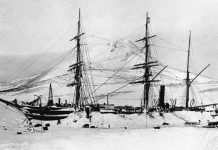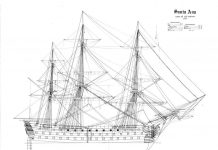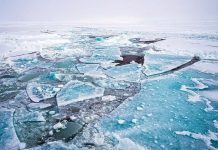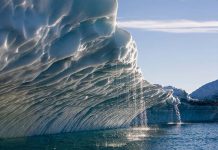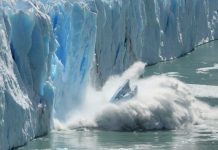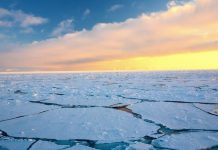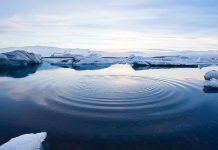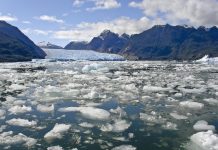In 25 days, having covered 365 miles, Cook reaches the starting line. During this time, he significantly replenishes food supplies due to successful hunting. There are 520 miles to the pole. On March 18, he begins his dash to the pole, with only two Eskimo kayurs with sleds of 13 dogs each. Thanks to the use of pemmican (dry meat powder filled with fat), it was possible to significantly reduce the cargo taken with them at the expense of food. Of course, pemmican was far from a delicacy, but it was hearty and weighed little.
After four crossings, the group came to a Large polynya, fortunately, it was covered with young ice, which withstood the travelers. Covering 20-30 miles in a day, Cook on March 30 went to the point from which he noticed the island, which he named Bradley Land (later it turned out that it was an iceberg frozen in ice). After two weeks, the speed of movement drops by almost half, as I wrote down, fatigue accumulates, thoughts of returning appear. Perhaps the other would have turned back, but Cook managed to pull himself together and continue his movement to the north. On April 21, he reached the North Pole!
At the northernmost point of the planet, he writes down his impressions: “Nothing remarkable; there is no pole as such; the sea with unexplored depths; the ice is more active; fresh cracks, divorces… Overwhelmed with joy, I can’t find words to express my satisfaction. How tired and exhausted we are! We need a rest.”
But there is just no time to rest, there is very little food, we must urgently return back. Exhausted people and dogs overcame the return journey with difficulty. Due to the fact that the sun was hidden behind clouds for three weeks, Cook was unable to make reliable determinations of his location, as a result, it was not possible to reach the food warehouse at Cape Svartenvog. The group was on the verge of starvation. Once again, Cook’s steadfastness and optimism affected, and despite all the difficulties, they managed to reach the land near the Ringnes Islands. Here they spent the winter at Cape Sparbo (Devon Island).
In the spring of 1909, Cook barely made it to Annoatoka, where he met an American tourist Whitney and two people from the Peary expedition. Having gained a little strength, Cook goes south to the Danish settlements, where a passing caravan of Eskimo teams follows. Leaving the Tent, he makes a mistake that will then give important trump cards to Piri – Cook temporarily leaves Whitney some of the documents and tools that he used on the campaign.
A victim of intrigue and lies from Lerwick (Shetland Islands): “On April 21, 1908, he reached the North Pole… The 2000-word text was left with the Danish consul. The cost is $3,000. If you agree, please contact us. Cook.” Just a week later, Robert Peary announced his conquest of the pole, and in his statement there were such lines: “Do not take Cook’s application seriously. His Eskimos say that he did not move far from the mainland, their tribesmen confirm.” Thus began a campaign to discredit Cook, which, as often happens in real life (unlike fairy tales and novels), ended with the complete defeat of the noble and not using forbidden techniques of the hero.
So that you can form your opinion about this scandalous story about the conquest of the North Pole, let’s focus a little on the personality of Robert Peary and his path to the North Pole. Even at a young age, Piri was distinguished by great ambitions, he wrote: “…I would like to get a name that would give me access to the circle of favorites, where I would feel on an equal footing with everyone.” As you can see, the young man did not dream of discovering new lands, he dreamed of glory and wanted to become the chosen one.
However, Robert’s education as a prospector did not allow him to count on much, and he did not have an uncle of a millionaire. Then Piri decided to make full use of his affiliation with the naval Department and his interest in the development of the Arctic regions. There were still white spots in the Arctic, the whole world was talking about polar travelers, that’s why Piri decided to look for his “bird of happiness” in the North.
In 1886, Perry went to Greenland, there are no special achievements for this expedition of his. To make people talk about themselves, a proud American decides to cross Greenland from sea to sea. However, his plans are destroyed by Fridtjof Nansen, who in 1888 with his companions was the first to cross the ice sheet of the largest island on Earth. Many polar explorers were surprised by Piri’s reaction at the time, he declares: “This execution of the enterprise I conceived dealt me a serious blow.”
In 1891, Peary went to Greenland again, it was then that he broke his leg, which was cured by Cook. In this expedition, Piri crossed the north of Greenland from Inglefield Bay to Independence Fjord, having traveled 2,200 kilometers both ways. In this expedition, it was possible to establish the northern limit of the Greenland ice sheet. It is curious that when Cook, after the expedition, wanted to publish his materials on observations of the life of the Eskimos, Piri categorically forbade it…
In the following years, Piri stubbornly tries to achieve some significant results, in the expedition of 1905-1906. he manages to beat Nansen’s record by a degree of latitude… It is amazing that it is on this expedition that, when returning, Piri manages to miss the intended point by 250 km. It turns out that the polar explorer, who has already become famous, hardly determines his location, making unforgivable navigational miscalculations…
In order not to repeat the mistake with a 250 km miss, Piri took Robert Bartlett, the captain of the expedition vessel, with him as a navigator. However, the Feast was not going to share the glory with him: at the last stage, he had to do all the calculations himself. During the day, his group covered 13-14 miles and on March 31 was not far from the 88th parallel. Here Piri left the last support unit, and Bartlett went back with him, who determined the latitude reached for Piri and gave him his calculations. It took Piri and the Eskimos accompanying him a week to get about 133 miles to the pole. The return trip to Cape Columbia passed without incident, and on April 23 they reached it. For Robert Peary, this “run” to the pole was like a sporting event, he did not spend time on scientific observations and any descriptions.
In Annoatoka, Piri learned that Cook was ahead of him by a year… Of course, this turn of events did not suit Piri at all. The interrogation of the Eskimos who accompanied Cook begins, it is concluded that this man was not at the pole… Piri realizes that if he does not destroy Cook, his youthful dream of worldwide fame and joining the “club of the chosen” will never come true. All means are good here. Whitney, to whom Cook left his materials and tools for safekeeping, asks Piri to take him on his ship. He agrees to take the tourist, but in return he must leave everything belonging to Cook in Greenland. Whitney has to either stay for the winter, or fulfill Piri’s condition, he chooses the latter…
At first, both polar explorers are honored in the USA, but Piri is not satisfied with this — he does not intend to share the glory. He continues to accuse Cook of cheating, the latter does not pay attention to it at first. But here Whitney, averting his eyes, informs him that the materials and tools are lost, Cook understands that his situation is extremely serious. A campaign initiated by Piri to discredit Cook is being launched in the media. Behind Piri’s back, the naval department, one might say, the state, Cook’s “rear” is much weaker, there are almost none…
In the newspapers, the “story” of the Eskimos (transmitted by Piri!), allegedly “incriminating” Cook, is discussed in all sorts of ways. It should be noted that at that time the Eskimos were just entering civilization and were naive simple children of nature, it was not difficult to confuse them, especially since they perceived all these “races” to the pole as nothing more than a whim of white people.
In order to completely crush the opponent, Piri exposes him as a long-time liar who has repeatedly misled the public with his invented achievements. Quite unexpectedly for Cook, the former groom of his Alaskan expedition suddenly declares that there was no conquest of the peak of Mckeepley. Since koshoch did not accompany Cook to the top, his testimony was not particularly serious, but suddenly Ed Barill, who was with Cook at the top, said the same thing… Curiously, relatively recently, Cook’s supporters in the United States found one very suspicious check, which allowed them to conclude that Barilla Piri bought a lie for $ 5,000.
The volume of the article does not allow us to list other accusations against Cook, the culmination of the harassment was his “confession” in the Hamptons in 1910, which he did not do. In it, Cook allegedly admitted that he had no confidence that he had reached the pole… The most interesting thing is that no one listened to the voice of famous polar explorers (Sverdrup, Amundsen, etc.) supporting Cook.
Alas, Cook suffered a complete defeat from Piri, he became known as a fraud and a liar, became an outcast in society. Now all his activities seemed to be one continuous fraud, so it is no wonder that Cook, who was engaged in the oil business, was soon sentenced to 15 years for attempting to sell plots allegedly deprived of oil. Later, these plots brought millions to the owners…
We must pay tribute to Amundsen, who visited Cook in prison, completely ignoring the possible attacks of the American press. For him, Cook was still the same reliable companion with whom they spent a difficult winter in Antarctica. Frederick Cook was released from prison in 1930, and was fully rehabilitated a few years later. Alas, this happened only a few months before Cook’s death. The man who blackened him died twenty years earlier.
In one fairly recent 10-volume encyclopedia, you can find a reference about the Feast that in 1909 he visited the North Pole, and there was nothing about Frederick Cook… This is not the worst option, in many reference publications Robert Peary is still called the conqueror of the North Pole. Meanwhile, the data obtained as a result of studies of near-polar space, currents, and the ice situation in this area showed that all the features of Frederick Cook’s route to the pole described by him correspond to reality. It was impossible to invent such a thing, so Cook actually reached the pole! Many polar explorers now have no doubt about this.
But Robert Peary, with his navigation abilities, could well have missed the cherished point, because he did not take a navigator with him on the last crossing…
There is an opportunity to establish the truth about climbing McKinley, because there is a book about it, which describes the features of the route. By the way, many people now have no doubt that Cook actually visited this peak.
I want to believe that the day is not far off when they will put an end to all this ugly history and the good name of Frederick Cook will be finally restored.



















